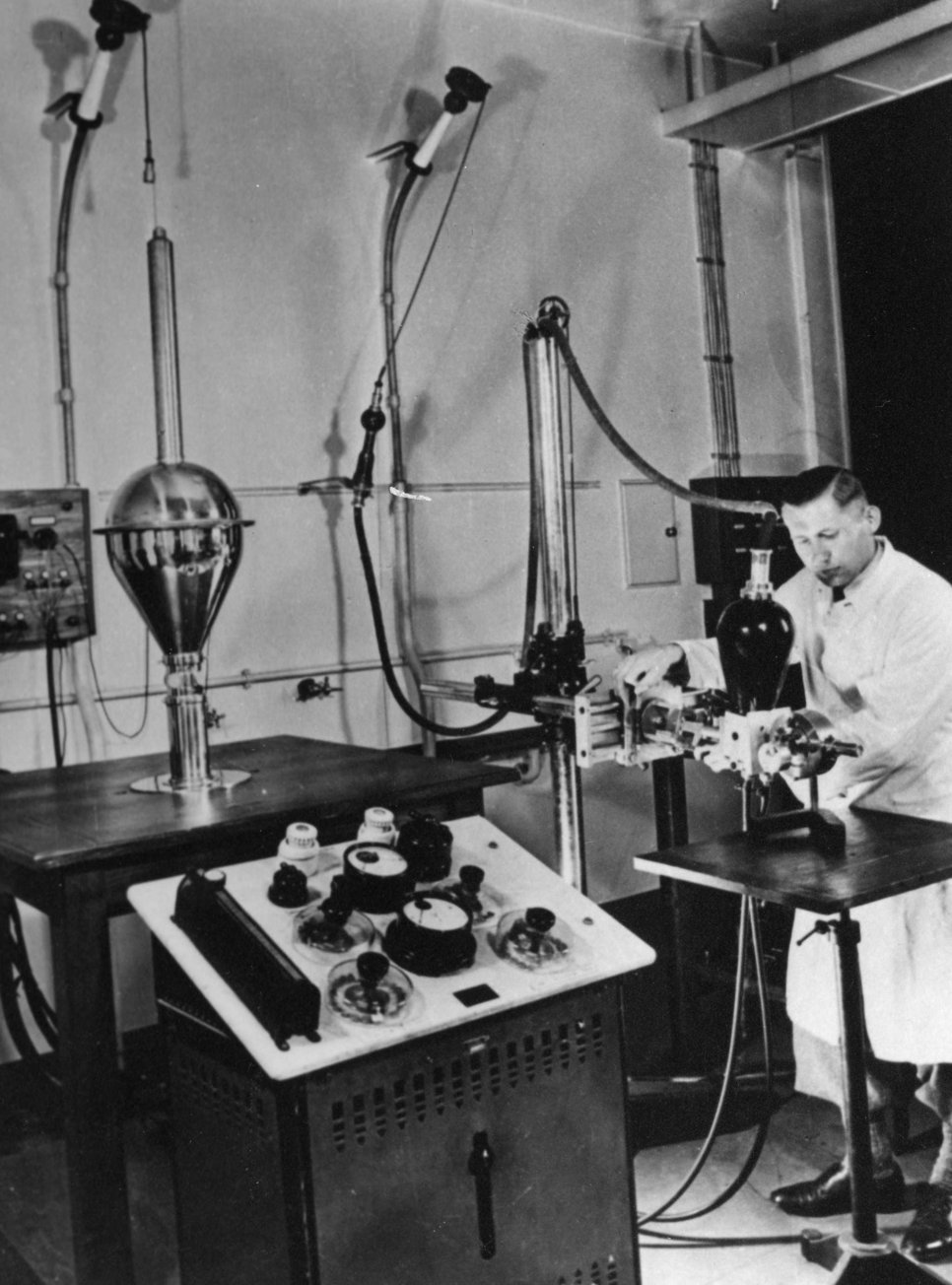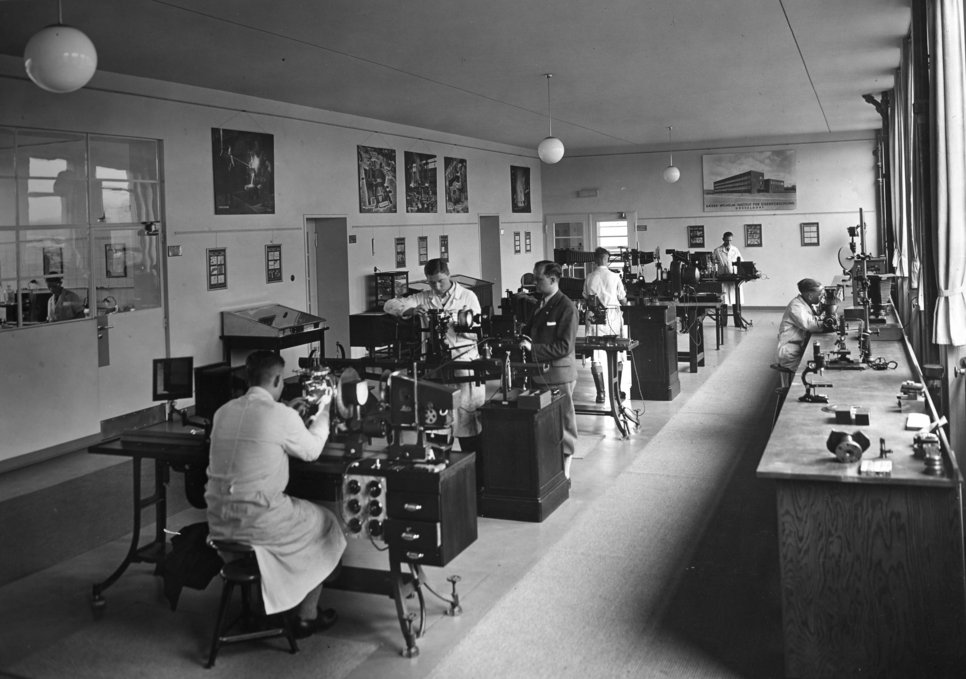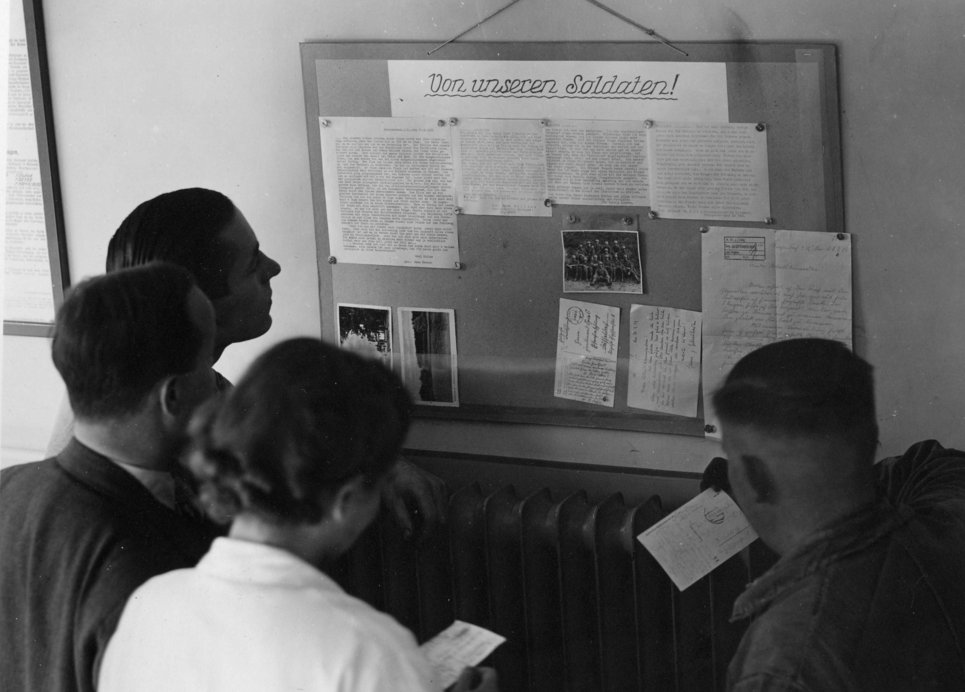
05: The Kaiser-Wilhelm-Institut für Eisenforschung during the Nazi Era until 1943
Following the Nazi's seizure of power, the Kaiser-Wilhelm-Institut für Eisenforschung (KWIE) thrived due to the Nazi rearmament and the unsatiable "hunger for iron" connected to this. [1]

The KWIE developed into one of the world's most modern research institutions of its field.[2] The upturn of the KWIE from 1933 onward also became visible with the implementation of the plan for a new building which had been postponed time and again for years. The beginning boom of the arms industry meant that the iron and steel industry was now able to provide financial resources for the construction of a new institute building. Together with subsidies from job creation schemes and with support from the city of Düsseldorf it was possible to finally create the building. In the autumn of 1935, the institute moved to its new building at August-Thyssen-Straße (now called Max-Planck-Straße) in Düsseldorf-Düsseltal.[3]
The KWIE had been integrated into the inter-institutional research association of the Reich's Ministry of Aviation since December, 1933. In various research groups the KWIE, together with industry, participated in studies on air armament.[4]
In order to meet the requirements of the four-year plan for the creation of a self-sufficient "Wehrstaat" (defence state) which had been initiated by Hitler and institutionalized by Hermann Göring, the institute intensified its studies regarding quality improvements of German steel and its production methods and the increased utilisation of domestic resources to save on foreign exchange.[5] Thus the KWIE made a major contribution not only to extending the use of scarce resources but also to optimising materials for weapon systems.[6]

The outbreak of World War II in 1939 was followed by an increase in extent and importance of war relevant research which had been assigned to the institute by various parts of the Wehrmacht. This resulted in close relations with the air force, the army and the navy, and, in the end, the KWIE was declared to be a „Wehrwirtschaftsbetrieb“ - an organisation relevant to the war economy - in 1940. Besides working on the development of substitute materials and new alloy systems, the institute also participated in research on tank tracks, machine guns, grenades, cartridges and high performance steels for firearm barrels, armour plating, gun barrels and aircraft.[7] All of this made the KWIE a centre of knowledge production relevant to armament during the Third Reich.
The close ties of the institute to the Nazi regime included also its employees: The comprehensive integration of the institute into armament research can be traced back to steel industrialist Albert Vögler, incumbent chairman of the board of trustees of the KWIE since 1936 and his close relations to the arms ministry. Along with Emil Kirdorf and Fritz Thyssen, Vögler had been one of the most important supporters of the Nazi movement within the heavy industry.[8] In addition, he had been acting as president of the Kaiser-Wilhelm-Gesellschaft (KWG) since 1941.[9]

Director Friedrich Körber, who had already worked for the KWIE in the 1920s and who had remained at the top of the institute after 1933, was a member of the Nazi party like the complete management of the institute.[10] Through their involvement in the numerous cross-institute research alliances and committees, research associates were integrated into the Nazi armament complex comprising industry, science, army and public bodies. Moreover, Körber was appointed to be divisional manager iron and steel within the Reichsforschungsrat (RFR) (National Research Council) in 1943. In 1937, the research council had been founded as an instrument of both the Heereswaffenamt and the ministry of science to implement the objectives of the four-year plan with the help of scientific and technological research.[11] Following the outbreak of World War II, a general enthusiasm for war and a high level of self- mobilisation were to be found in most employees of the KWIE. This resulted from their own nationalist attitude and was further encouraged by both Körber and the general administration of the KWG.[12] All in all, the KWG can be accused of "anticipatory adaptation" to the Nazi state. This extensive „self-coordination" found its expression, among other things, in the dismissal of Jewish staff. This was based on the "Law to Restore a Professional Civil Service" which had been passed on 7th April 1933 and which was implemented quickly and unreservedly within the KWG.[13] There has been no evidence found for dismissals at the Düsseldorf institute.
Overall, the KWG benefited from its willingness to participate in the Nazi system, particularly in the increase of the number of its institutes and in financial grants.[14] Its involvement in armament research was conducive to the reputation of the KWG during the Nazi era and was therefore continuously intensified. Most scientists regarded their cooperation with military agencies not only as a matter of course in serving the "fatherland", but also as an opportunity to obtain additional financial resources for their research.[15]
[1] Flachowsky, Sören: Von der Wagenburg der Autarkie zu transnationaler Zusammenarbeit. Der Verein Deutscher Eisenhüttenleute und das KWI/MPI für Eisenforschung 1917-2009, in: Maier, Helmut; Zilt, Andreas; Rasch, Manfred (publ.): 150 Jahre Stahlinstitut VDEh 1860-2010, Essen 2010, p. 671-708, p. 683.
[2] Flachowsky, Sören: Das Max-Planck-Institut für Eisenforschung Düsseldorf; in: Gruss, Peter; Rürup, Reinhard (publ.): Denkorte. Max-Planck-Gesellschaft und Kaiser-Wilhelm-Gesellschaft: Brüche und Kontinuitäten 1911-2011, Dresden, 2010, p. 128-135, p. 130.
[3] Ibid., p. 683f.
[4] Id.: „Alle Arbeit des Instituts dient mit leidenschaftlicher Hingabe der deutschen Rüstung“. Das Kaiser-Wilhelm-Institut für Eisenforschung als interinstitutionelle Schnittstelle kriegsrelevanter Wissensproduktion 1917-1945, in: Maier, Helmut: Gemeinschaftsforschung, Bevollmächtigte und der Wissenstransfer: die Rolle der Kaiser-Wilhelm-Gesellschaft im System kriegsrelevanter Forschung des Nationalsozialismus, Göttingen, 2007, p. 153-214, p. 170-177.
[5] Flachowsky: Von der Wagenburg der Autarkie zu transnationaler Zusammenarbeit, p. 684.
[6] Ibid., p. 687.
[7] Ibid.
[8] Hachtmann, Rüdiger: Wissenschaftsmanagement im „Dritten Reich“. Geschichte der Generalverwaltung der Kaiser-Wilhelm-Gesellschaft (2 vol.), Göttingen, 2007, vol. 2, p. 850.
[9] Flachowsky: Von der Wagenburg der Autarkie zu transnationaler Zusammenarbeit, p. 687.
[10] Ibid., p. 689f.
[11] The RFR was subdivided into individual divisions which were managed by usually reputable scientists whose task it was to both award and evaluate research assigments. Flachowsky: „Alle Arbeit des Instituts …“, p. 193 and p. 199f.
[12] Hachtmann, Rüdiger: Wissenschaftsmanagement im „Dritten Reich“, vol. 2, p. 813.
[13] Renn, Jürgen; Kant, Horst; Kolboske, Birgit: Stationen der Kaiser-Wilhelm-/ Max-Planck-Gesellschaft, in: Hoffmann, Dieter; Kolboske, Birgit; Renn, Jürgen: „Dem Anwenden muss das Erkennen vorausgehen“. Auf dem Weg zu einer Geschichte der Kaiser-Wilhelm-/ Max-Planck-Gesellschaft, 2nd ext. edition., Berlin, 2015, p. 5-120, p. 34.
[14] Ibid., p. 39 ff.
[15] Ibid., p. 44.


